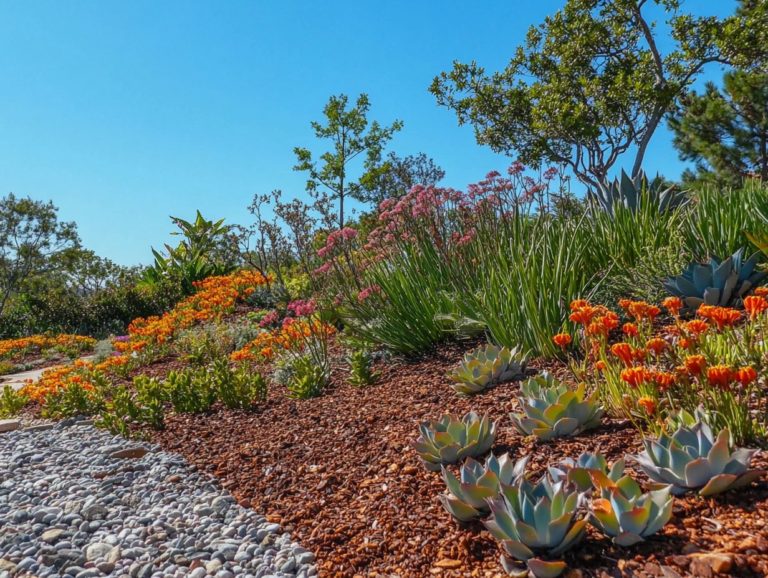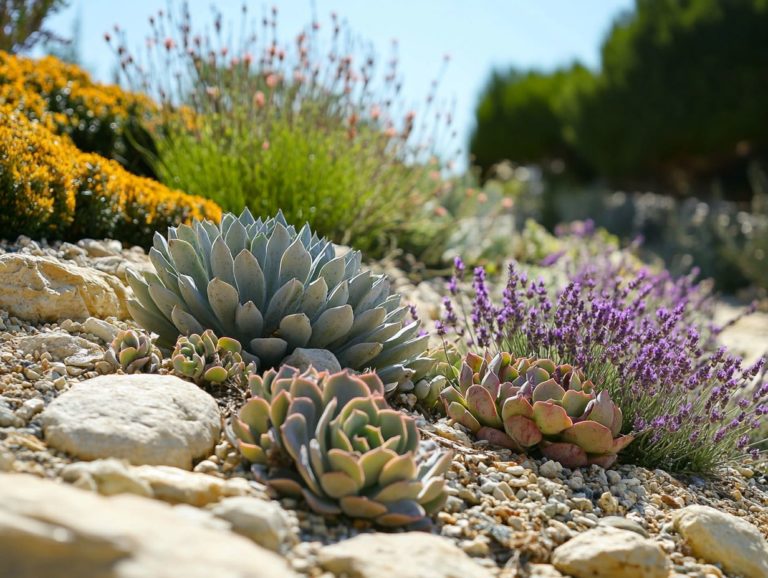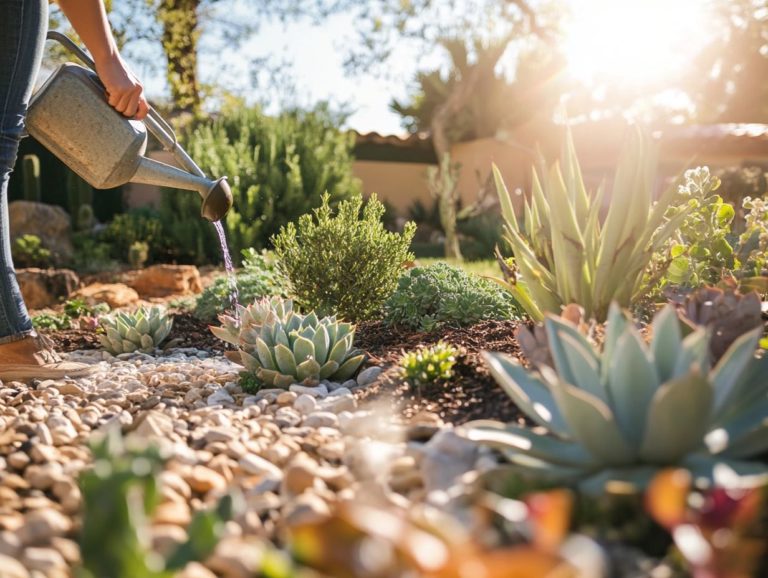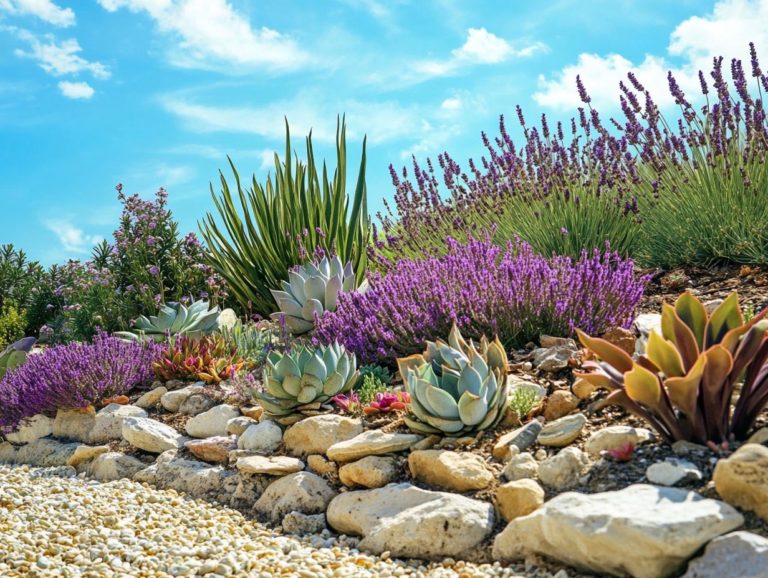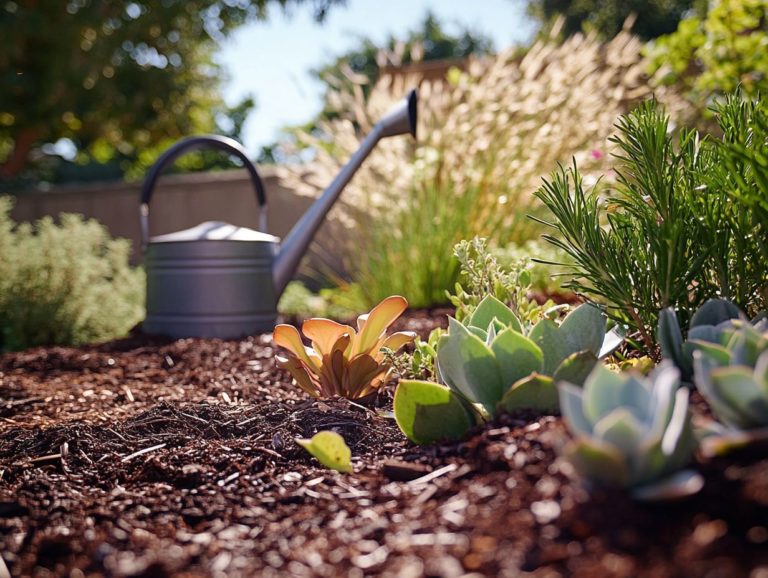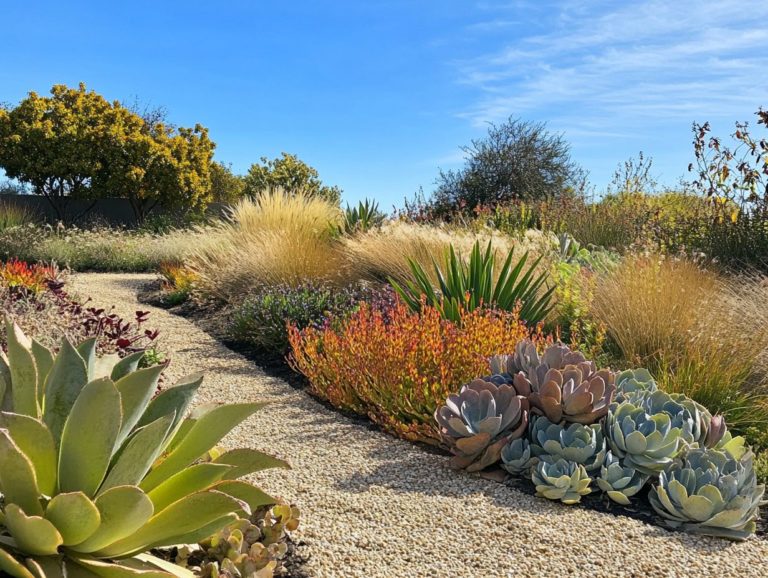Understanding the Benefits of Xeriscaping
Xeriscaping transcends mere gardening trends; it embodies a sustainable landscaping philosophy that emphasizes water conservation and harmony with the environment.
Emerging from arid regions, this practice transforms your perspective on gardening. It delivers advantages not just for the planet but also for your wallet and well-being.
Explore what xeriscaping truly involves, learn how to adapt it to various climates, and dispel the common myths that may be hindering your journey. Understanding planning your garden is essential for successful implementation.
By mastering the principles of xeriscaping, you can fully embrace a greener, more sustainable lifestyle that enhances property value and promotes biodiversity.
Contents
Key Takeaways:
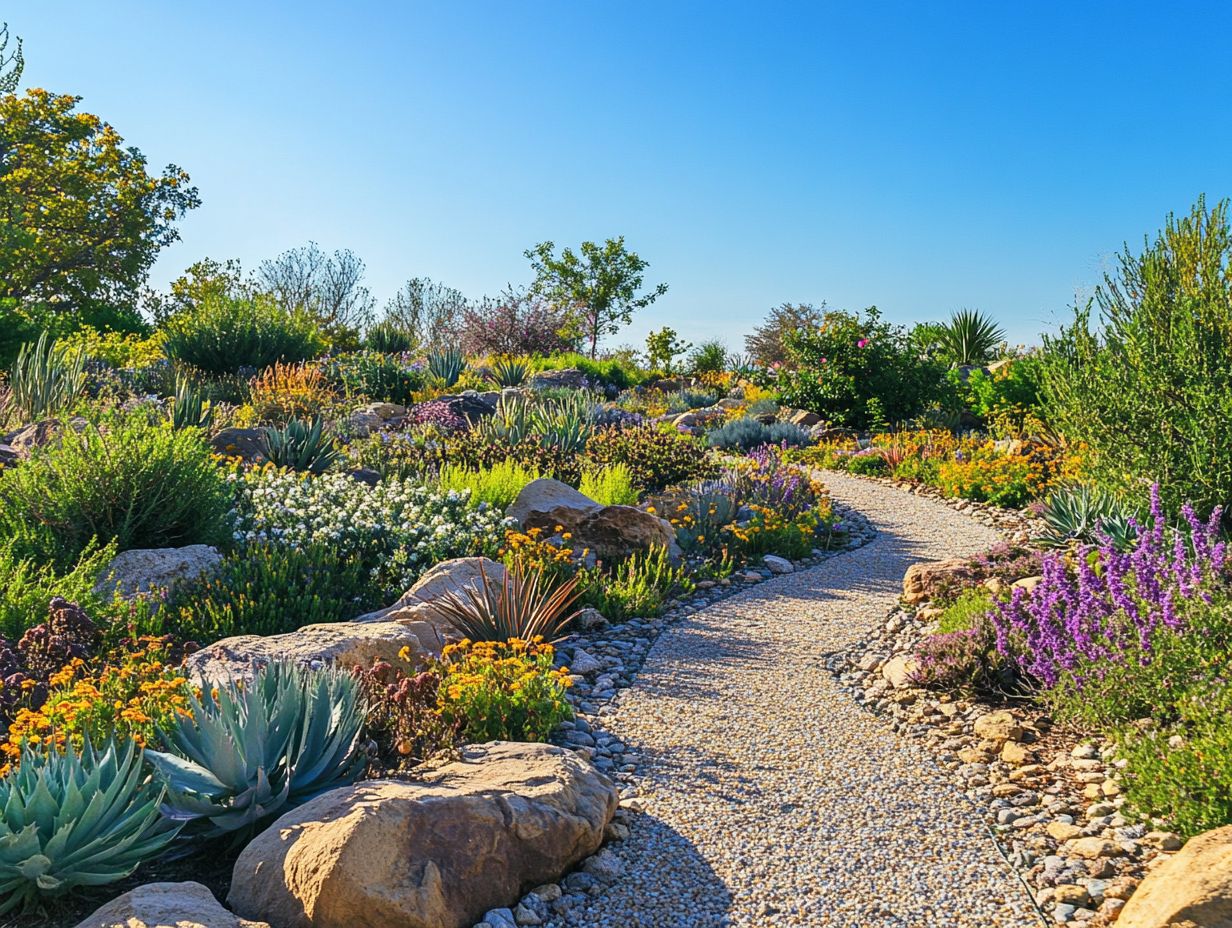
- Xeriscaping is a landscaping method that conserves water and promotes environmental sustainability.
- Implementing xeriscaping can lead to financial savings on water and maintenance costs while also improving your physical and mental well-being.
- With proper planning and maintenance, xeriscaping is adaptable to different climates and helps create beautiful, low maintenance gardens that thrive in harmony with the surrounding ecology.
What is Xeriscaping?
Xeriscaping offers you a sustainable landscaping solution aimed at conserving water through the use of plants that need little water, significantly reducing your irrigation needs. This approach is especially pertinent in regions like Central Texas, where water restrictions can vary with climate fluctuations.
By embracing this landscaping practice, you not only elevate the beauty of your outdoor space but also foster biodiversity by incorporating native plants and other eco-friendly landscaping techniques that are well-suited to the Texas landscape.
Benefits of Xeriscaping
Xeriscaping presents an array of benefits that go far beyond simple visual appeal. You ll enjoy significant environmental advantages, such as improved water conservation, enhanced biodiversity, and increased property value all stemming from sustainable landscaping practices.
This makes xeriscaping an appealing choice for both homeowners and commercial property owners seeking to make a positive impact.
Environmental Benefits
The environmental benefits of xeriscaping are remarkable. This landscaping technique places a strong emphasis on water conservation while simultaneously enhancing biodiversity by creating habitats for native wildlife. It fosters a more sustainable outdoor ecosystem.
By choosing drought-resistant plants and minimizing the use of high-water-demand species, you significantly reduce water usage and align with eco-friendly landscaping practices. These practices promote the growth of local flora and fauna, which in turn supports a vibrant wildlife habitat.
When you incorporate organic materials into the soil, you enrich the environment. This leads to healthier ecosystems that can thrive with minimal human intervention.
As you embrace xeriscaping, you actively contribute to the preservation of regional species and encourage an ecological balance that benefits both nature and your community.
Financial Benefits
Financially, xeriscaping is a smart move, as it can significantly lower landscaping costs and reduce your utility bills through efficient irrigation systems and minimal maintenance. This makes it an excellent choice for both homeowners and businesses alike.
As you adopt sustainable practices, you may discover various financial incentives from local governments encouraging environmentally friendly landscaping. These perks can come in the form of grants or tax breaks, enhancing your overall cost efficiency.
The long-term financial advantages extend beyond immediate savings; xeriscaping can also boost your property values, yielding a lucrative return on investment. By choosing this eco-conscious approach, you positively impact the environment and strengthen your financial position in the competitive real estate market.
Health Benefits
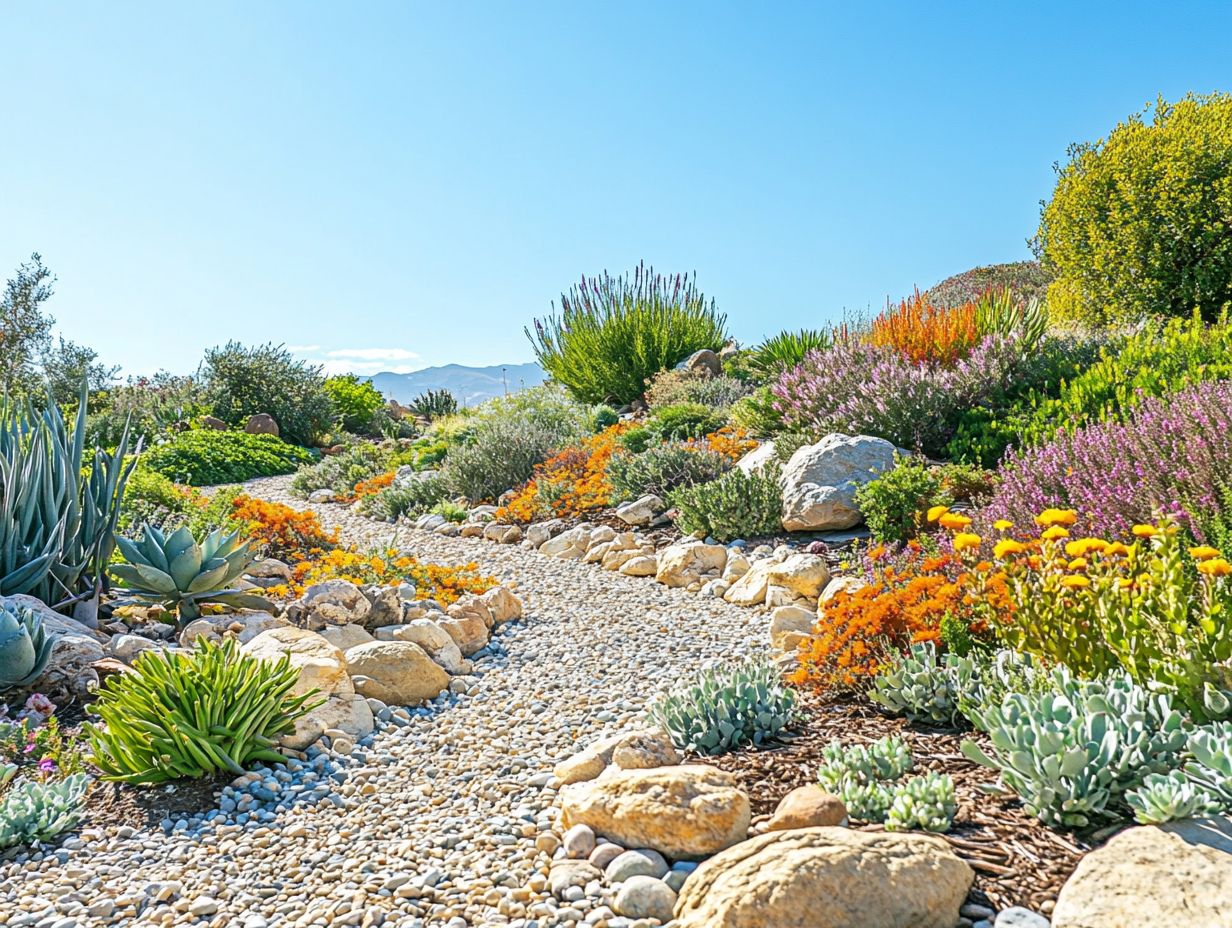
The health benefits of xeriscaping go beyond mere environmental considerations; they invite you to experience the joy of gardening and engage actively with your outdoor space. This connection with nature can significantly enhance your mental well-being.
By cultivating a xeriscaped garden, you re not just playing your part in water conservation; you re also crafting a tranquil space that promotes relaxation and mindfulness. The vibrant colors and textures of plants that need less water will uplift your spirits. Plus, the physical activities involved in gardening like planting, weeding, and landscape maintenance will keep you fit and encourage a healthier lifestyle.
Incorporating simple gardening tips, such as planting native species or designing efficient irrigation systems, can deepen your appreciation for the ecosystem. Ultimately, spending time in a thoughtfully designed garden offers therapeutic benefits, providing you with opportunities for both reflection and rejuvenation.
How to Xeriscape
Xeriscaping requires careful planning, and this comprehensive guide will empower you to adopt sustainable landscaping practices. You’ll delve into checking the soil’s health, carefully selecting suitable plant materials, and thoughtfully reducing turfgrass. Instead, opt for drought-tolerant groundcovers and ornamental grasses that enhance your outdoor space.
Step-by-Step Guide
In this step-by-step guide to xeriscaping, you’ll explore essential aspects such as xeriscape design principles, the installation of efficient irrigation systems, and the strategic use of mulch to enhance water retention while minimizing maintenance.
By focusing on these critical elements, you can create a sustainable landscape that flourishes with minimal water use. Understanding xeriscape design principles is vital; these guidelines emphasize the harmony between plants and their environment, allowing for natural growth while significantly reducing the need for irrigation.
When you install efficient irrigation systems, like drip lines, you’ll ensure that water is delivered directly to the roots of your plants, dramatically improving water conservation. Integrating mulch into your landscape serves a crucial role in retaining soil moisture, suppressing weeds, and regulating temperature, ultimately leading to a healthier garden that requires less upkeep.
Xeriscaping in Different Climates
Xeriscaping can be adapted to suit various climates, enabling you to create a vibrant landscape whether you’re in an arid region or an area with distinct drought seasons.
By incorporating heat-tolerant and local plants, you ll cultivate a thriving garden that aligns perfectly with your local water requirements.
Adapting to Different Environments
Adapting xeriscaping to your specific environment requires a keen understanding of climate variations and the water needs of local plants. This knowledge is essential for crafting a successful landscape design that flourishes even in the face of environmental challenges.
You ll want to consider not just the regional climate but also soil types, sunlight exposure, and typical rainfall patterns. By choosing plants that need less water and are well-suited to your surroundings, you significantly boost your chances of cultivating a resilient garden.
Smart landscaping practices, like grouping plants based on their water requirements and using mulches to retain moisture, can make a remarkable difference in achieving a sustainable landscape. This thoughtful approach not only conserves water but also creates a vibrant environment that beautifully complements the unique ecological characteristics of your area.
Maintaining a Xeriscape Garden
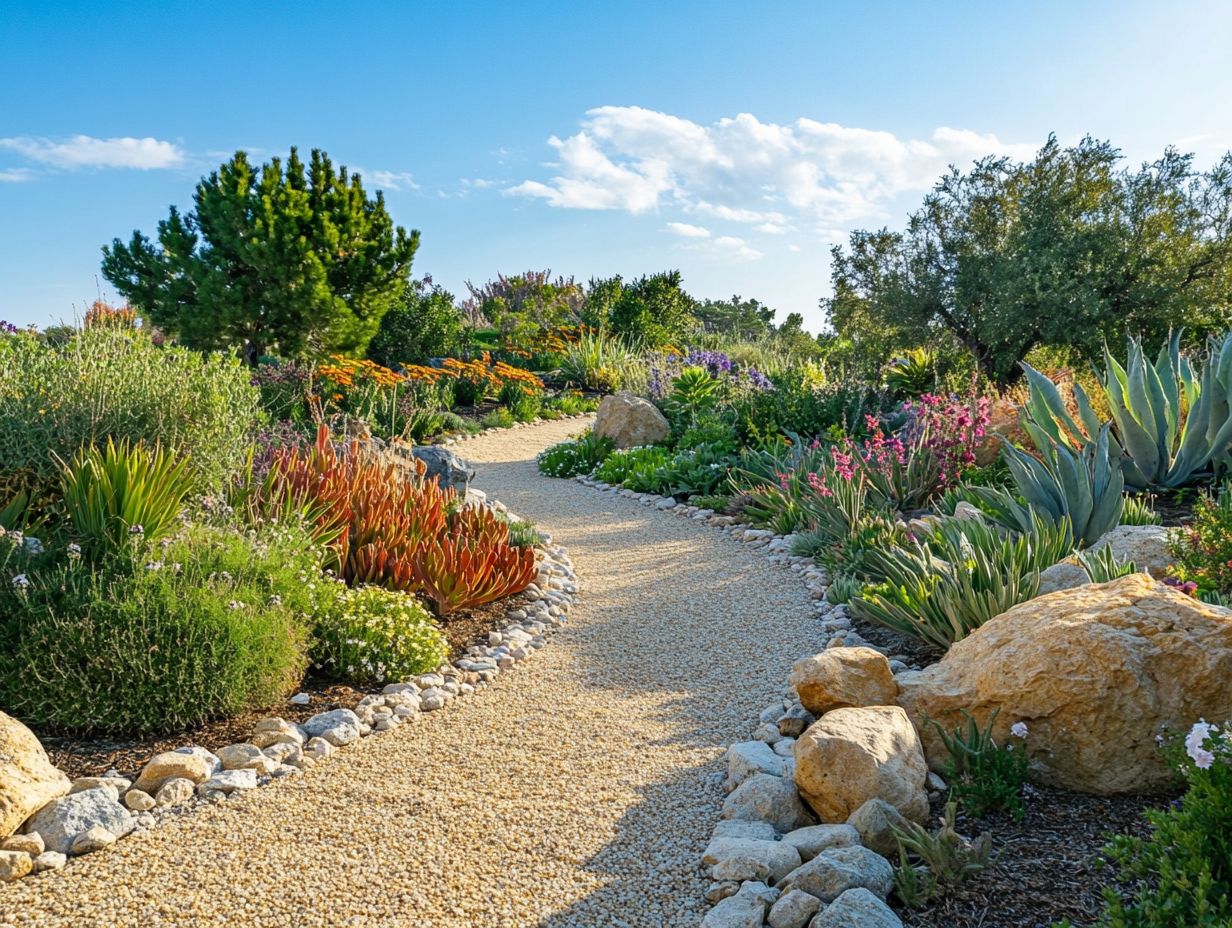
Maintaining a xeriscape garden requires a little planning and creativity! You ll need to engage in long-term planning, implement effective irrigation strategies, conduct regular soil analyses, and select native plants.
This careful attention not only fosters sustainability but also significantly reduces ongoing maintenance efforts, allowing you to enjoy a flourishing garden with minimal fuss.
Ready to transform your outdoor space? Start planning your xeriscape garden today!
Tips for Long-Term Maintenance
For the long-term maintenance of your xeriscaped garden, it’s essential to use organic materials and regularly inspect your planting beds. Additionally, monitor the wildlife habitat your landscape fosters to ensure its health.
Using specific maintenance methods helps your garden thrive and contribute positively to the ecosystem. Consider employing organic gardening practices, such as using compost and mulch, to enrich the soil and retain moisture effectively.
Regularly checking the health of your plants helps you detect any issues early on, supporting the overall vitality of your garden. Encouraging native wildlife by providing suitable habitats can significantly enhance biodiversity.
These thoughtful practices preserve the garden’s beauty while promoting a healthier planet and combating issues such as habitat loss and environmental impact.
Common Misconceptions About Xeriscaping
Understanding xeriscaping benefits and strategies like turfgrass reduction can help dispel myths surrounding this sustainable practice.
Common misconceptions about xeriscaping suggest that it results in desolate landscapes and necessitates stringent water restrictions. However, thoughtful landscaping practices can transform your outdoor space into a vibrant oasis, brimming with gardening delights and a rich variety of plant life.
Debunking Myths and Misunderstandings
Debunking prevalent misconceptions illuminates the many benefits of xeriscaping, especially its vital role in sustainable landscaping. This approach conserves water and enhances the beauty and functionality of your outdoor spaces.
You might think that xeriscaping results in a barren, lifeless yard stripped of color and vitality. However, research reveals that this method showcases a variety of native plants that thrive with minimal upkeep.
Experts emphasize that carefully selected flora can create vibrant ecosystems, providing habitat for local wildlife while using significantly less water than traditional lawns. Plus, incorporating mulch improves soil health and helps reduce evaporation, maximizing every precious drop of water.
When you embrace these eco-friendly practices, you not only beautify your home you make a real difference in your community and help combat the effects of climate change.
Xeriscaping Resources and Tools
To effectively implement xeriscaping, ensure you have access to an array of resources and tools. This includes specialized gardening tools, drought-tolerant plant materials, and efficient irrigation systems tailored to meet your local water requirements.
Frequently Asked Questions
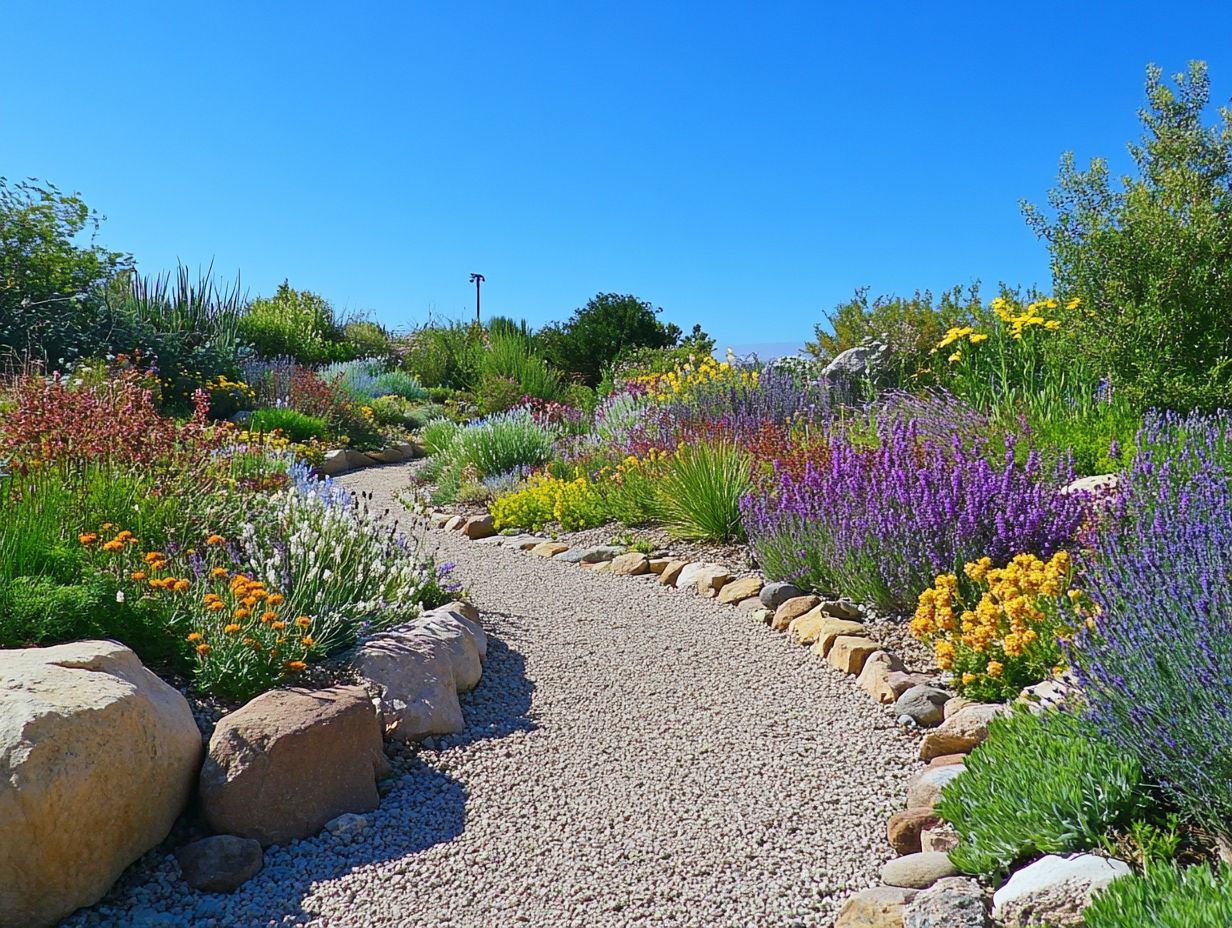
What is xeriscaping and why is it beneficial?
Xeriscaping uses native, drought-resistant plants to save water and costs while creating beauty. This landscaping method reduces water usage and maintenance expenses.
How does xeriscaping help the environment?
Xeriscaping conserves water resources, reduces the need for chemical fertilizers and pesticides, and provides habitats for native wildlife. It also helps to minimize air pollution and erosion.
What are the financial benefits of xeriscaping?
Xeriscaping can save homeowners and businesses money on their water bills and maintenance costs. It increases property value and attracts potential buyers or customers with its low-maintenance and eco-friendly appeal.
Does xeriscaping require a lot of effort and maintenance?
Xeriscaping is designed to be low-maintenance, requiring less effort and upkeep compared to traditional landscaping. Once established, native plants used in xeriscaping need little to no fertilizers, pesticides, or watering.
Can xeriscaping be used in all climates?
Xeriscaping can be adapted to various climates. However, it is most commonly used in arid and semi-arid regions where water is scarce.
How do I get started with xeriscaping?
Xeriscaping is landscaping that reduces water use. Excited to transform your garden? Start by researching native plants and their water needs!
Plan your landscape design and think about adding mulch, rocks, and drip irrigation to save water. Consult a professional landscaper who specializes in xeriscaping to get expert guidance.

